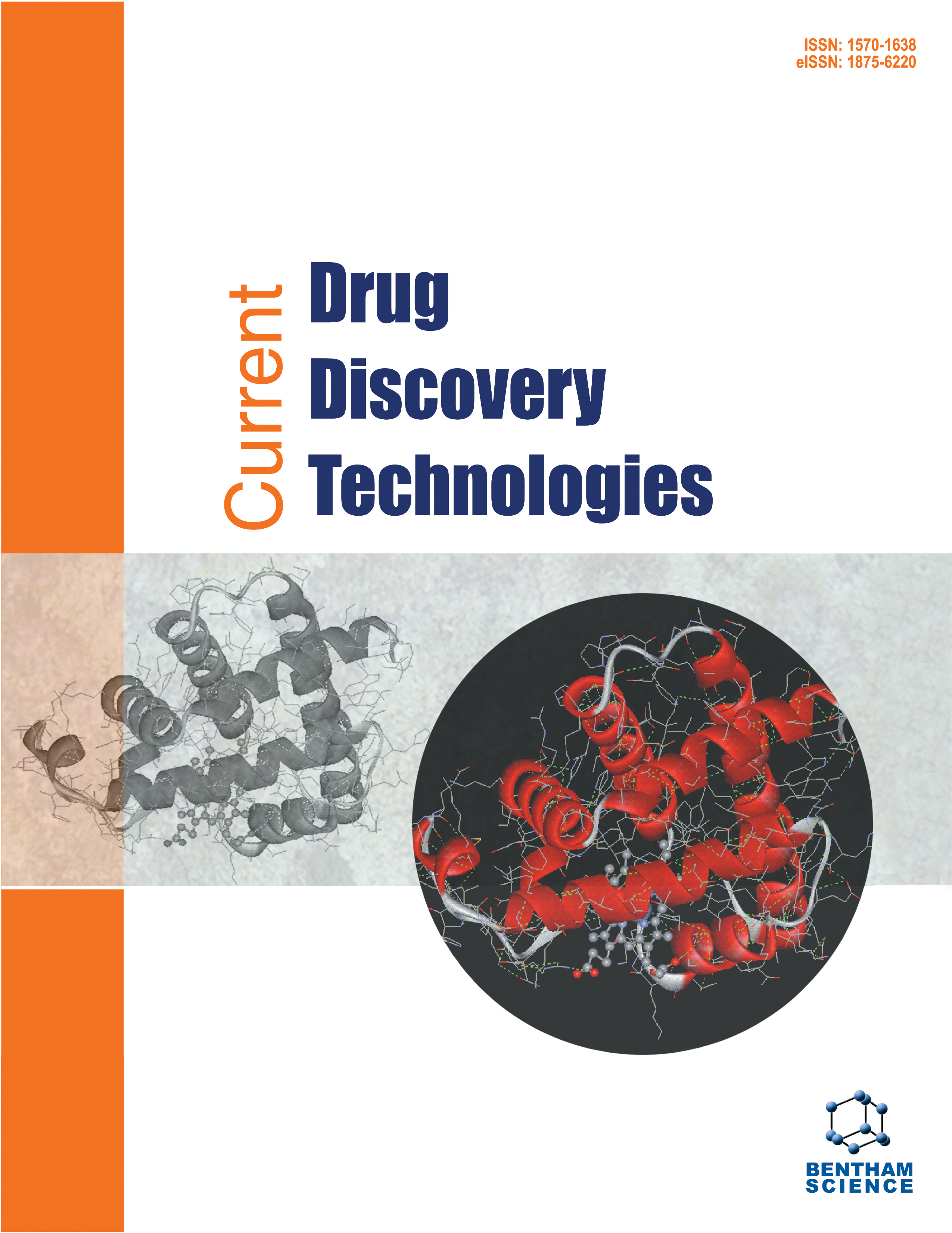- Home
- A-Z Publications
- Current Drug Discovery Technologies
- Previous Issues
- Volume 8, Issue 1, 2011
Current Drug Discovery Technologies - Volume 8, Issue 1, 2011
Volume 8, Issue 1, 2011
-
-
oa Editorial [Hot Topic: New Strategy for Drug Discovery Using Monoclonal Antibody (Guest Editor: Yukihiro Shoyama)]
More LessThe authors in this thematic issue provide a comprehensive summary of most recent knowledge on the relation of natural products and monoclonal antibody (MAb) in order to expand the new technologies for drug discovery. Although MAbs are now indispensable in the biological field, they are rare phytochemical research areas except naturally occurring therapeutic medicines like morphine, taxol and vinblastine and s Read More
-
-
-
Immunochemical Approach Using Monoclonal Antibody against Δ 9-Tetrahydrocannabinolic Acid (THCA) to Discern Cannabis Plants and to Investigate New Drug Candidates
More LessA monoclonal antibody (MAb-4A4) against Δ9-tetrahydrocannabinolic acid (THCA) showing extensive crossreactivity against various cannabinoids was prepared. Using this antibody, a competitive enzyme-linked immunoassay (ELISA) was developed to detect Δ9-THCA in the range of 1 to 100 μg/ml. Various cannabinoids including Δ9-THC (Δ9- tetrahydrocannabinolic acid), Δ8-THCA (Δ8-tetrahydrocannabinolic acid), Δ8-THC (Δ8- Read More
-
-
-
Preparation of Knockout Extract for Determination of Really Active Compound Using MAb
More LessAuthors: Takuhiro Uto, Indree Tuvshintogtokh and Yukihiro ShoyamaThe crude-rhizome extract of P. japonicus was loaded on the immunoaffinity column conjugated with antiginsenoside- Rb1 monoclonal antibody (MAb) and washed with the washing solvent, followed by elution solvent, to give fraction 2 containing higher concentration of compound 1. Compound 1 clearly indicated a dammarane saponin having protopanaxadiol as a framework and three sugars in a molecule suggesting Read More
-
-
-
Technology of Compact MAb and its Application for Medicinal Plant Breeding Named as Missile Type Molecular Breeding
More LessSingle-chain variable fragment (scFv) enhanced solasodine glycoside accumulation in Solanum khasianum hairy root cultures transformed by the scFv against solamargine (As-scFv) gene. The scFv protein was expressed at a high level in inclusion bodies of E. coli. After being renatured, the scFv protein was purified in a one-step manner by metal chelate affinity chromatography. The yield of refolded and purified scFv was 12. Read More
-
-
-
Bioactivity of American Ginseng by Knockout Extract Preparation Using Monoclonal Antibody
More LessAuthors: Chun-Su Yuan and Hiroyuki TanakaWe produced anti-ginsenoside Re (GRe)-4G10 monoclonal antibody that specifically recognizes GRe and used this to prepare an immunoaffinity column to remove GRe from American ginseng berry extract (AGBE) (thus producing GRe knock-out AGBE (GRe-KO-AGBE)). We compared the anti-diabetic and anti-obesity effects of AGBE and GRe- KO-AGBE in adult diabetic C57BL/6J ob/ob mice. Fasting blood glucose levels and body Read More
-
-
-
Development of New Staining Technology “Eastern Blotting” Using Monoclonal Antibody
More LessAuthors: Osamu Morinaga and Yukihiro ShoyamaGinsenosides contained in Panax species were separated by silica gel TLC blotted to a polyvinylidene difluoride (PVDF) membrane which was dipped in a sodium periodide (NaIO4) solution and reacted with protein, preparing a ginsenoside-protein conjugate for binding a ginsenoside on a PVDF membrane. The blotted spots were stained by anti-ginsenoside-Rb1 monoclonal antibody (MAb) and anti-ginsenoside-Rg1MAb, respectiv Read More
-
-
-
Immunofluorescence and Immunoelectron Microscopic Localization of Medicinal Substance, Rb1, in Several Plant Parts of Panax ginseng
More LessAuthors: Sadaki Yokota, Yuko Onohara and Yukihiro ShoyamaIt is important to know the localization of medicinal substance, Rb1, of Ginseng, Panax ginseng, in this plant in order to achieve efficient extraction of Rb1 or to culture producing cells. In this report, we describe the localization of Rb1 in various parts of the plant as determined by immunofluorescence (IF) and immunoelectron microscopies (IEM). Using IF, we show that Rb1 is localized to chloroplasts, peroxisomes a Read More
-
-
-
Quality Control of Traditional Chinese Medicine by Monoclonal Antibody Method
More LessAuthors: Ming-Ying Shang, Min Tian, Hiroyuki Tanaka, Xiao-Wei Li, Shao-Qing Cai and Yukihiro ShoyamaIn a previous study, we reported the preparation, characterization, variation, specificity, and sensitivity of an anti-aristolochic acid-II (AA-II) monoclonal antibody. The preparation procedure was as follows. AA-II conjugated with bovine serum albumin was used as an antigen for immunizing BALB/c mice. Splenocytes isolated from the immunized mice were fused with an aminopterin-sensitive mouse myeloma cell Read More
-
-
-
Asparaginyl-tRNA Synthetase Pre-Transfer Editing Assay
More LessAminoacyl-tRNA synthetases (AARSs) are a structurally heterogeneous family of enzymes present in prokaryotes, archaea and eukaryotes. They catalyze the attachment of tRNA to its corresponding amino acid via an aminoacyl adenylate intermediate. Errors in protein synthesis will occur if an incorrect amino acid is attached to the tRNA. To prevent such errors, AARSs have evolved editing mechanisms that eliminate incorre Read More
-
Volumes & issues
-
Volume 22 (2025)
-
Volume 21 (2024)
-
Volume 20 (2023)
-
Volume 19 (2022)
-
Volume 18 (2021)
-
Volume 17 (2020)
-
Volume 16 (2019)
-
Volume 15 (2018)
-
Volume 14 (2017)
-
Volume 13 (2016)
-
Volume 12 (2015)
-
Volume 11 (2014)
-
Volume 10 (2013)
-
Volume 9 (2012)
-
Volume 8 (2011)
-
Volume 7 (2010)
-
Volume 6 (2009)
-
Volume 5 (2008)
-
Volume 4 (2007)
-
Volume 3 (2006)
-
Volume 2 (2005)
-
Volume 1 (2004)
Most Read This Month
Article
content/journals/cddt
Journal
10
5
false
en


